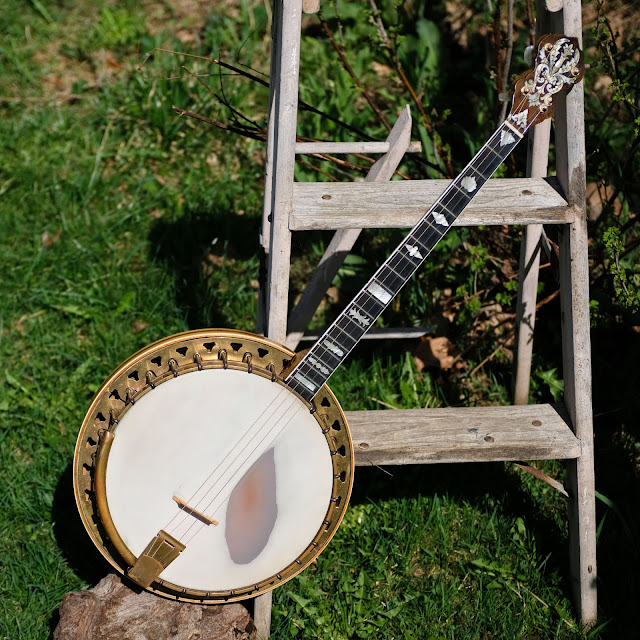1930 Vega Vegaphone Artist Resonator Tenor Banjo
I won't argue with fancy tenor banjos -- just last week I had a gold-plated '20s Epiphone in. This week I've got this gold-plated, hum-dinger of a Vega in via a consignor. The "Artist" model Vegaphone was down just one rung from the top-of-the-line Vegaphone and features the same general build (with Tubaphone tonering) as the other Vegaphone models but with a lot of bling. In 1928 the Artist model cost $250. To put that in frame of reference, a Gibson L-5 carved-top guitar was only $25 more and, heck, you could have a decent Gibson flattop at the time for about $35. This was squarely aimed at pro players and sounds and looks it, too.
This banjo came in the shop in pretty good shape and with almost all of its original hardware (the head, one section of binding on the resonator, and frets are replacements), though it is refinished, the pearl Vega "medallion" is missing at the back of the headstock, and a repairman before me mucked-up the dowel and thinned it up right where the neck joins the pot (the bit hidden in the rim). The guts were good, however, so after a fret level/dress, a bunch of cleaning, and a good setup, it's playing beautifully and has to be one of the loudest tenors this side of a fancy Groton-made Bacon or Lange-made Paramount that I've played. This slices, dices, and cuts like the best of them -- while still maintaining that clean, airy, zung-zung-zung sort of lilt to the tone.
It's got a two-piece flamed maple neck, ebony fretboard, multi-ply rim with heavy-duty hardware and flange, a flamed-maple resonator, pearl inlay all over the neck, and some nice heel carving. It's rich.
Specs are: 23" long scale, 1 5/32" nut width, 15/16" string spacing at the nut, 1 11/32" spacing at the bridge, 10 7/8"rim (with synthetic head), and 13 1/2" resonator back. Action is spot-on 1/16" at the 12th fret, it's strung 30w, 20w, 13, 9 for CGDA standard tuning, and the neck is straight and stable. It has a medium, C/V hybrid shape to the back of the neck.
The engraved inlay kills it. Note that the headstock veneer is ebonized pearwood or maple.
I'm pretty sure that the 10th and 19th fret inlays are non-original, but it's possible they are.
Nice, flamey resonator, huh?
I'm pretty sure the geared tuners are original, though the buttons may be replacements.
Here's that fantastic heel carving.
While the finish has been refinished, it's an old job and there are new weather-checked finish cracks and whatnot to keep the sense of the instrument beautifully old. I had to scratch my head a lot looking at details at first to confirm that
In the above picture you can see the replacement smaller patch of binding on the resonator's bottom edge.
There's so much engraved pearl throughout that the company saw fit to hide the bit on the back of the heel under the resonator.
As far as the neck join area goes, however, it's complicated. The original neck brace with its adjustable mechanism works to help hold the neck just fine, but the dowel has been thinned-down right where it passes through the rim and into the heel. This meant that I didn't 100% trust the dowel to do all the neck-mounting work indefinitely, so I sunk a hidden screw/bolt behind the neck brace's plate that passes through the rim and into the heel (Gibson-style) for extra support. It's all good and completely hidden.
Even the Tubaphone tonering is gold-plated.
It comes with a beat-up but period (and non-original) tenor hard case.

































Comments